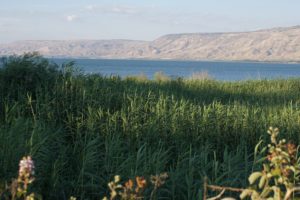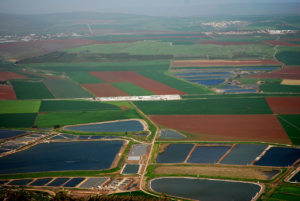N.B.: I am in the Holy Land at this time. As my travel schedule is heavy, I am republishing some articles about life in Jesus’ day. I hope you will enjoy reading (or re-reading) them as much as I did.
The climate in Palestine, both today and at the time of Jesus, has two distinct seasons. The wet or rainy season runs from the mid-October to the mid-April while the dry season lasts from the mid-June to mid-September. During the dry season rainfall is rare. Although it can get very hot during summer, it often does not feel that way. Cool breezes and low humidity are typical, making the summers quite pleasant, especially in areas directly on the coast or on the higher slopes of the hills. During these months it is almost always sunny and the sky cloudless. Rain rarely falls during the summer because of the dominance of high-pressure zones. This provides challenges for farmers, who have to develop special methods for trapping water during the rainy season. During rainy season, although it does not rain every day, there can be significant rains that cause periodic flooding. While it gets cool in the winter and at higher altitudes (areas near Jerusalem and Bethlehem can even see snow), this is rare and usually limited to brief periods during December and January. Although the Bible refers snow in the area, it is mostly mentioned as occurring in the mountains to the north near Mt. Hermon.
The climate of the Holy Land varies from north to south and from east to west. Because the topography is varied there can be dramatic differences within a few miles. Generally, there is more rain in the eastern part of Palestine and it gets hotter the farther south one travels. The Dead Sea region and the area around Jericho are deep crevasses and pure desert. The mountainous regions have more rain on the west side than on the east side. The hottest days of the year occur during the transition between the two seasons.
The climate of Israel in Jesus’ day may not have been quite as warm and dry as it is today. Several references in Scripture would seem to imply that the land was wetter and more suitable for agriculture, without the need for the significant irrigation that is prevalent in the Middle East today. For example,
And Lot lifted up his eyes, and beheld all the plain of Jordan, that it was well watered everywhere, before the LORD destroyed Sodom and Gomorrah, even as the garden of the LORD, like the land of Egypt, as thou comest unto Zoar (Genesis 13:10).
And the LORD said, I have surely seen the affliction of my people which are in Egypt, and have heard their cry by reason of their taskmasters; for I know their sorrows; And I am come down to deliver them out of the hand of the Egyptians, and to bring them up out of that land unto a good land and a large, unto a land flowing with milk and honey (Exodus 3:7,8).
The Bible also describes Solomon’s use of prodigious quantities of lumber to build the Temple and other buildings (circa 1000 B.C.)
Land-use studies throughout the Mediterranean, North Africa, and the Middle East show the prevalence of crops and forests, which were well suited to the cooler, wetter climates in the period before 1000 B.C.
Just as is the case today, in Jesus’ time the highly varied topography strongly affected the microclimate from mile to mile.
 Lower Galilee (pictured at left), where Jesus lived most of His life, was Israel’s lushest region, known for its sunny, temperate climate and its spring-watered lands. Each spring, the valleys and slopes became an ocean of wildflowers and blossoming trees. Beginning in March, the area was covered by a vast blanket of green. The fertile land was a texture of vineyards and fruit orchards. Grapes, figs, olives, pomegranates, oranges, and other fruits flourished in its pleasant, subtropical climate.
Lower Galilee (pictured at left), where Jesus lived most of His life, was Israel’s lushest region, known for its sunny, temperate climate and its spring-watered lands. Each spring, the valleys and slopes became an ocean of wildflowers and blossoming trees. Beginning in March, the area was covered by a vast blanket of green. The fertile land was a texture of vineyards and fruit orchards. Grapes, figs, olives, pomegranates, oranges, and other fruits flourished in its pleasant, subtropical climate.
The first century Jewish historian Flavius Josephus, who knew the area well, wrote this about it:
Its nature is wonderful as well as its beauty; its soil is so fruitful that all sorts of trees can grow upon it, and the inhabitants accordingly plant all sorts of trees there; for the temper of the air is so well mixed, that it agrees very well with those several sorts, particularly walnuts, which require the coldest air, flourish there in vast plenty; there are palm trees also, which grow best in hot air; fig trees also and olives grow near them, which yet require an air that is more temperate. One may call this place the ambition of nature, where it forces those plants that are naturally enemies to one another to agree together; it is a happy contention of the seasons, as if every one of them laid claim to this country; for it not only nourishes different sorts of autumnal fruit beyond men’s expectation, but preserves them a great while; it supplies men with the principal fruits, with grapes and figs continually, during ten months of the year and the rest of the fruits as they become ripe together through the whole year (The Jewish War, Book 3, Chapter 10:8).
Around the Sea of Galilee crops were plentiful and fish were abundant. Despite its name, the Sea of Galilee is a fresh water lake, about 13 miles long and 8 miles wide. The typical crops grown in the region in Jesus’ day were grain, olives, and grapes. The drier area to the east of the Sea of Galilee had less vegetation.

An area to the south between Galilee and Samaria is called the Valley of Jezreel (pictured at right) and featured rich soil and moderate rainfall. Judea, south of Samaria, has a gradual change in landscape, but the most notable change is the decrease in rainfall.
Since Jesus’ time the overall area has undergone gradual desertification, a process through which once-fertile land becomes desert (typically due to natural factors such as drought or through inappropriate agriculture). Desertification in the area has become especially noticeable during the last few centuries, although it had been occurring to some degree even before Jesus’ time. This leads to less water, less arable land, warmer days, and cooler nights. The chief human contributors to this gradual change have been wars and poor land management. Deforestation was a major issue during the Jewish-Roman War of 66-70 A.D, but in the past two thousand years there have been many other factors causing environmental damage as well.
It seems a reasonable conclusion that in Jesus’ day, the climate was noticeably more moderate and wet than it is today, with more trees. However, there still are many beautiful regions, especially in Galilee in the north. We ought not to overestimate the difference in climate between the ages; although it would be noticeable to people of His day, it would not astonish them. The decrease in the number of trees would likely be more noticeable to them than the slightly warmer, drier weather.
Israel currently has a program that is attempting to reverse the desertification by planting trees (cedars, the same type used by Solomon!). It has received a huge amount of private financial support. They are, in effect, attempting to partially reforest Israel. The expected result is that the land will hold more water, permitting more land to be available for farming.


The climate is in the safe hands of God the Father Almighty who has counted the very hairs of your head.
Wow! That was quite an eye-opener, Monsignor. Such a different picture of the climate and vegetation in the Holy Land than I had gotten from Scripture. I look at the picture of Lower Galilee, and it’s no wonder the Lord could escape the crowds as much as He did – He could have just disappeared into the forest!
In other words, the climate of the Holy land is a lot like California. It always gripes me around Christmas time when people start mooning over a “real” Christmas with snow, and jingle bells and snowmen, and reindeer, etc, etc, when the fact is the first Christmas in Bethlehem (presuming it occurred at December 25) was much more like Christmas in Los Angeles.
Hmm…. Bethlehem gets snow. It can be pretty cold at least for a time in winter.